Influence of Cumulative Geotechnical Deterioration on Mass Movement at a Medium-Scale Regional Analysis (Cortinas Sector, Toledo, Colombia)
Abstract
:1. Introduction
2. Study Area
3. Background
4. Methods of Analysis
4.1. Hazard Analysis Methodology
4.1.1. Geo-Environmental Characterization
4.1.2. Susceptibility Analysis
4.2. Analysis of Hazard and Its Association with Cumulative Geotechnical Deterioration (CGD)
5. Results in the Cortinas Sector
5.1. Inventory of Morphodynamic Processes
5.2. Conditioning Factors
- A constant loss is observed for 18 years, of forest-type coverages and semi-natural areas comprising: dense high terra firme forests, dense forests, dense high terra firme forests and gallery and riparian forests. However, a slight recovery is seen in the 2018 of gallery and riparian forests.
- Secondary, transitional or high vegetation-type coverages have been intermittent during the study periods.
- Heterogeneous agricultural areas comprising pasture mosaics with natural spaces have completely disappeared.
- The areas with mainly clean pastures have been in constant growth and are generally used for economic activities such as cattle raising.
5.3. Susceptibility
5.4. Triggering Factors
5.5. Hazard
5.6. Cumulative Geotechnical Deterioration of the Sector
- A natural hazard has been identified and characterized.
- Such hazard has been classified at the high level on the medium 1:25,000 scale.)
- The methodology for the analysis of mass removal phenomena at a 1:25,000 scale proposed by the Colombian Geological Survey (SGC) in 2017 has been adopted verbatim.
- It is required to improve the approach to the prediction of ground collapse.
- If there has not been any ground disturbance yet, there is the option to validate or modify the monitoring techniques being applied; in either case, we return to modeling for failure prediction.
- If it is identified that the ground has already been affected to the point of collapse, there is definitely an emergency that must be dealt with according to traditional techniques.
- If it is identified that the ground has indeed been affected, but has not yet collapsed, field explorations are made at a 1:5000 and 1:2000 scale (which will be the subject of future work), and it is determined whether to intervene by means of designs and the corresponding construction. This activity is followed by the validation/modification of the monitoring of the effectiveness of the work. If it is determined not to intervene, the monitoring is continued directly.
- The validation and modification of the modeling for failure prediction.
- The monitoring of the conditioning factors.
- Change in vegetation cover by taking aerial images of the landslide 2.
- Daily rainfall data from 1 March 2023 to 31 May 2024.
- Topographic monitoring of control points.
5.6.1. Landslide Event in San Bernardo de Bata
5.6.2. Landslide Event PK 7 + 860 (Alto de La Muerte)
5.6.3. Event PK 9 + 350 (Landslide D intermediate Zone between Landslide A and B Cortinas—2021 (Figure 4)
5.6.4. Failure Event PK 23 + 345 (Canoas)
6. Discussion
7. Conclusions
Author Contributions
Funding
Data Availability Statement
Acknowledgments
Conflicts of Interest
Appendix A
| Date | Latitude | Longitude | Depth (km) | Magnitude (MI) | Date | Latitude | Longitude | Depth (km) | Magnitude (MI) |
|---|---|---|---|---|---|---|---|---|---|
| 5 Februrary 2016 | 7.214 | −72.284 | 0 | 1.3 | 8 August 2019 | 7.248 | −72.316 | 0.25 | 1.8 |
| 8 April 2016 | 7.179 | −72.283 | 18.8 | 1.3 | 24 August 2019 | 7.265 | −72.325 | 0 | 2.3 |
| 10 June 2016 | 7.402 | −72.166 | 0 | 1.9 | 24 August 2019 | 7.232 | −72.312 | 0 | 2.3 |
| 5 August 2016 | 7.28 | −72.321 | 79 | 1.3 | 24 August 2019 | 7.254 | −72.323 | 0 | 2.6 |
| 19 October 2016 | 7.317 | −72.303 | 122.7 | 1.6 | 25 August 2019 | 7.158 | −72.188 | 3.98 | 2.2 |
| 24 December 2016 | 7.333 | −72.184 | 28.7 | 1.4 | 17 September 2019 | 7.154 | −72.307 | 0.81 | 2.3 |
| 23 February 2017 | 7.324 | −72.398 | 87.6 | 1.4 | 21 September 2019 | 7.434 | −72.486 | 0.65 | 1.4 |
| 26 February 2017 | 7.275 | −72.284 | 68.5 | 0.9 | 22 September 2019 | 7.311 | −72.236 | 0 | 1.6 |
| 8 March 2017 | 7.317 | −72.178 | 4 | 2.1 | 8 November 2019 | 7.266 | −72.174 | 0 | 1.6 |
| 15 April 2017 | 7.384 | −72.314 | 8.7 | 1.1 | 8 November 2019 | 7.199 | −72.216 | 0 | 2.2 |
| 29 May 2017 | 7.389 | −72.127 | 0 | 1.5 | 12 November 2019 | 7.318 | −72.184 | 0 | 1.8 |
| 5 July 2017 | 7.401 | −72.266 | 4.8 | 0.8 | 28 November 2019 | 7.115 | −72.277 | 0 | 2.3 |
| 31 August 2017 | 7.305 | −72.299 | 9.5 | 1.2 | 12 December 2019 | 7.097 | −72.242 | 13.07 | 2.1 |
| 21 November 2017 | 7.36 | −72.143 | 3.9 | 1.8 | 14 December 2019 | 7.099 | −72.305 | 59.3 | 1.4 |
| 25 April 2018 | 7.113 | −72.098 | 4.8 | 2.1 | 3 February 2020 | 7.075 | −72.199 | 0.12 | 2.7 |
| 19 June 2018 | 7.078 | −72.193 | 0.23 | 1.6 | 8 February 2020 | 7.104 | −72.368 | 5.41 | 1.7 |
| 14 July 2018 | 7.147 | −72.183 | 0 | 2.3 | 25 February 2020 | 7.116 | −72.366 | 2.87 | 1.6 |
| 18 July 2018 | 7.112 | −72.165 | 4 | 2.4 | 7 March 2020 | 7.167 | −72.132 | −1.7 | 3 |
| 9 September 2018 | 7.247 | −72.41 | 15.46 | 1.5 | 27 May 2020 | 7.097 | −72.153 | 26.66 | 1.5 |
| 2 October 2018 | 7.175 | −72.319 | 0.01 | 1.7 | 17 June 2020 | 7.111 | −72.202 | 0 | 1.9 |
| 2 October 2018 | 7.122 | −72.391 | 29.53 | 2.2 | 23 July 2020 | 7.337 | −72.452 | 0 | 1.5 |
| 2 October 2018 | 7.224 | −72.294 | 31.17 | 1.6 | 23 July 2020 | 7.39 | −72.409 | −0.01 | 1.6 |
| 3 October 2018 | 7.204 | −72.385 | −0.01 | 1.6 | 6 August 2020 | 6.988 | −72.246 | 1.25 | 2.2 |
| 21 October 2018 | 7.119 | −72.241 | 3.54 | 1.8 | 7 August 2020 | 7.17 | −72.23 | 21.4 | 1.5 |
| 21 October 2018 | 7.193 | −72.314 | 0 | 2.2 | 12 August 2020 | 7.388 | −72.387 | −1.28 | 2.1 |
| 21 October 2018 | 7.34 | −72.271 | 0 | 1.7 | 22 August 2020 | 7.06 | −72.077 | 0.66 | 2.3 |
| 23 November 2018 | 7.087 | −72.226 | 4.38 | 1.3 | 13 September 2020 | 7.198 | −72.248 | 0 | 1.6 |
| 2 January 2019 | 7.148 | −72.188 | −1.33 | 1.9 | 18 September 2020 | 7.094 | −72.345 | 6.69 | 1.4 |
| 5 January 2019 | 7.324 | −72.47 | 45.35 | 1.7 | 19 October 2020 | 7.218 | −72.17 | −1.61 | 1.7 |
| 6 January 2019 | 7.051 | −72.209 | 1.92 | 1.5 | 15 November 2020 | 7.08 | −72.297 | 16.33 | 1.8 |
| 7 January 2019 | 7.038 | −72.132 | 0 | 1.7 | 7 December 2020 | 7.012 | −72.25 | 15.86 | 1.5 |
| 17 January 2019 | 7.092 | −72.248 | 3.7 | 1.9 | 2 January 2021 | 7.047 | −72.101 | −0.71 | 2.1 |
| 17 January 2019 | 7.143 | −72.168 | 0.06 | 2.2 | 28 January 2021 | 7.168 | −72.131 | −1.7 | 1.9 |
| 18 January 2019 | 7.136 | −72.179 | 3.82 | 1.8 | 29 January 2021 | 7.053 | −72.145 | 14.53 | 4.3 |
| 19 January 2019 | 7.204 | −72.398 | −0.02 | 1.8 | 2 February 2021 | 7.101 | −72.128 | 0.94 | 1.8 |
| 23 January 2019 | 7.128 | −72.2 | 4.1 | 2.1 | 13 February 2021 | 7.139 | −72.156 | 7.08 | 1.8 |
| 23 January 2019 | 7.117 | −72.172 | 3.29 | 2.6 | 30 April 2021 | 7.147 | −72.306 | 19.14 | 1.6 |
| 24 January 2019 | 7.129 | −72.198 | 4.94 | 2 | 30 April 2021 | 7.179 | −72.273 | 16.09 | 1.6 |
| 24 January 2019 | 7.185 | −72.189 | 1.4 | 1.8 | 15 May 2021 | 7.185 | −72.31 | 13.05 | 1.7 |
| 24 January 2019 | 7.174 | −72.166 | 3.91 | 2.1 | 16 May 2021 | 7.063 | −72.284 | 5.31 | 1.9 |
| 24 January 2019 | 7.129 | −72.193 | 1.84 | 2 | 16 May 2021 | 7.398 | −72.512 | 13.16 | 1.6 |
| 24 January 2019 | 7.122 | −72.195 | 2.85 | 2.3 | 28 June 2021 | 7.064 | −72.241 | 1.55 | 1.8 |
| 24 January 2019 | 7.092 | −72.248 | 4.36 | 1.9 | 6 July 2021 | 7.026 | −72.279 | 10.35 | 2.2 |
| 25 January 2019 | 7.112 | −72.228 | 4.5 | 1.6 | 10 July 2021 | 7.164 | −72.137 | 0 | 1.8 |
| 11 February 2019 | 7.05 | −72.205 | 3.84 | 2 | 16 July 2021 | 7.266 | −72.198 | 5.55 | 1.6 |
| 13 February 2019 | 7.144 | −72.24 | 3.39 | 1.9 | 16 July 2021 | 7.071 | −72.096 | 26.64 | 2.1 |
| 27 March 2019 | 7.092 | −72.125 | 3.29 | 1.3 | 16 July 2021 | 7.075 | −72.1 | 13.05 | 1.9 |
| 30 March 2019 | 7.192 | −72.352 | −0.01 | 1.4 | 17 July 2021 | 7.04 | −72.277 | 26.52 | 2.4 |
| 4 April 2019 | 7.301 | −72.255 | 15.42 | 1.7 | 17 July 2021 | 7.101 | −72.085 | 2.79 | 1.8 |
| 18 April 2019 | 7.031 | −72.25 | 3.84 | 1.6 | 17 July 2021 | 7.045 | −72.123 | 23.01 | 2 |
| 6 May 2019 | 7.094 | −72.239 | 3.73 | 3.6 | 17 July 2021 | 7.07 | −72.095 | 25.35 | 2.2 |
| 8 May 2019 | 7.296 | −72.38 | 33.17 | 1.4 | 8 August 2021 | 7.118 | −72.237 | 13.05 | 2 |
| 13 May 2019 | 7.345 | −72.2 | 0 | 1.7 | 9 August 2021 | 7.06 | −72.171 | 0.16 | 1.7 |
| 14 May 2019 | 7.262 | −72.213 | 0 | 1.5 | 25 August 2021 | 7.058 | −72.225 | 43.55 | 1.4 |
| 18 May 2019 | 7.204 | −72.398 | −0.02 | 1.4 | 31 August 2021 | 7.345 | −72.264 | 0 | 1.6 |
| 22 May 2019 | 7.143 | −72.166 | 4.52 | 1.9 | 27 September 2021 | 7.349 | −72.493 | 21.13 | 1.9 |
| 3 June 2019 | 7.063 | −72.16 | 7.25 | 3.2 | 29 September 2021 | 7.301 | −72.489 | 0 | 1.7 |
| 3 June 2019 | 7.076 | −72.191 | 3.57 | 2.8 | 8 October 2021 | 7.071 | −72.112 | 10.75 | 1.9 |
| 4 June 2019 | 7.073 | −72.171 | 0.34 | 3.3 | 25 October 2021 | 7.207 | −72.301 | 4.61 | 1.5 |
| 19 June 2019 | 7.328 | −72.238 | 0 | 1.9 | 28 October 2021 | 7.071 | −72.169 | 3.87 | 1.7 |
| 28 June 2019 | 7.018 | −72.248 | 4.19 | 1.8 | 5 November 2021 | 7.219 | −72.25 | 23.83 | 1.7 |
| 29 June 2019 | 7.095 | −72.264 | 3.29 | 1.9 | 5 December 2021 | 7.021 | −72.251 | 22.77 | 2.4 |
References
- Körner, C.; Ohsawa, M. 2005. Chapter 24: Mountain systems. In Ecosystems and Human Well-Being: Current State and Trends; Hassan, R., Scholes, R., Ash, N., Eds.; Island Press: Washington, DC, USA, 2005; Volume 1, pp. 681–716. Available online: https://www.millenniumassessment.org/en/Condition.html (accessed on 5 March 2024).
- Slaymaker, O.; Embleton-Hamann, C. Advances in global mountain geomorphology. Geomorphology 2018, 308, 230–264. [Google Scholar] [CrossRef]
- Cruden, D.M.; Varnes, D.J. Landslide Types and Processes. In Landslides: Investigation and Mitigation, Transportation Research Board; Turner, A.K., Shuster, R.L., Eds.; Special Report No. 247; Transportation Research Board: Denver, Colorado, USA, 1996; pp. 36–75. [Google Scholar]
- Unidad Nacional Para la Gestión del Riesgo de Desastres. n.d. Riesgos por Movimientos en Masa en Colombia. UNGRD. Available online: https://portal.gestiondelriesgo.gov.co/Paginas/Noticias/2020/Riesgo-por-movimientos-en-masa-en-Colombia.aspx#:~:text=De%20acuerdo%20con%20datos%20de,familias%20se%20han%20visto%20afectadas (accessed on 15 December 2023).
- Anbazhagan, S.; Ramesh, V. Landslide hazard zonation mapping in ghat road section of Kolli hills, India. J. Mt. Sci. 2014, 11, 1308–1325. [Google Scholar] [CrossRef]
- Fayaz, M.; Meraj, G.; Khader, S.A.; Farooq, M.; Kanga, S.; Singh, S.K.; Kumar, P.; Sahu, N. Management of Landslides in a Rural–Urban Transition Zone Using Machine Learning Algorithms—A Case Study of a National Highway (NH-44), India, in the Rugged Himalayan Terrains. Land 2022, 11, 884. [Google Scholar] [CrossRef]
- Skilodimou, H.D.; Bathrellos, G.D.; Kosskeridou, E.; Soukis, K.; Rozos, D. Physical and anthropogenic factors related to landslide activity in the northern Peloponnese, Greece. Land 2018, 7, 85. [Google Scholar] [CrossRef]
- Pacheco, R.; Velastegui-Montoya, A.; Montalván-Burbano, N.; Morante-Carballo, F.; Korup, O.; Deleles, C. Land use and land cover as a conditioning factor in landslide susceptibility: A literature review. Landslides 2023, 20, 967–982. [Google Scholar] [CrossRef]
- Fell, R.; Corominas, J.; Bonnard, C.; Cascini, L.; Leroi, E.; Savage, W.Z. Guidelines for landslide susceptibility, hazard and risk zoning for land use planning. Eng. Geol. 2008, 102, 85–98. [Google Scholar] [CrossRef]
- Bogaard, T.A.; Greco, R. Landslide hydrology: From hydrology to pore pressure. Wires Water 2016, 3, 439–459. [Google Scholar] [CrossRef]
- Valdés Carrera, A.C.; Mendoza, M.E.; Allende, T.C.; Macías, J.L. A review of recent studies on landslide hazard in Latin America. Phys. Geogr. 2023, 44, 243–286. [Google Scholar] [CrossRef]
- Varnes, D.J. Landslide Hazard Zonation: A Review of Principles and Practice; Natural Hazard Series; UNESCO: Paris, Italy, 1984; Volume 3, p. 63. [Google Scholar]
- Lee, S.; Talib, J.A. Probabilistic landslide susceptibility and factor effect analysis. Environ. Geol. 2005, 47, 982–990. [Google Scholar] [CrossRef]
- Corominas, J.; Moya, J. A review of assessing landslide frequency for hazard zoning purposes. Eng. Geol. 2008, 102, 193–213. [Google Scholar] [CrossRef]
- Da Silva, R.P.; Lacerda, W.A.; Coelho Netto, A.L. Relevant geological-geotechnical parameters to evaluate the terrain susceptibility for shallow landslides: Nova Friburgo, Rio de Janeiro, Brazil. Bull. Eng. Geol. Environ. 2022, 81, 57. [Google Scholar] [CrossRef]
- Manzo, G.; Tofani, V.; Segoni, S.; Battistini, A.; Catani, F. GIS techniques for regional-scale landslide susceptibility assessment: The Sicily (Italy) case study. Int. J. Geogr. Inf. Sci. 2013, 27, 1433–1452. [Google Scholar] [CrossRef]
- Harp, E.L.; Reid, M.E.; McKenna, J.P.; Michael, J.A. Mapping of hazard from rainfall-triggered landslides in developing countries: Examples from Honduras and Micronesia. Eng. Geol. 2009, 104, 295–311. [Google Scholar] [CrossRef]
- Huabin, W.; Gangjun, L.; Weiya, X.; Gonghui, W. GIS-based landslide hazard assessment: An overview. Prog. Phys. Geogr. Earth Environ. 2005, 29, 548–567. [Google Scholar] [CrossRef]
- Do Pinho, T.M.; Augusto Filho, O. Landslide susceptibility mapping using the infinite slope, SHALSTAB, SINMAP, and TRIGRS models in Serra do Mar, Brazil. J. Mt. Sci. 2022, 19, 1018–1036. [Google Scholar] [CrossRef]
- Unidad Nacional Para la Gestión del Riesgo de Desastres. n.d. Consolidado Anual de Emergencias. UNGRD. Available online: http://portal.gestiondelriesgo.gov.co/Paginas/Consolidado-Atencion-de-Emergencias.aspx (accessed on 17 December 2023).
- Servicio Geológico Colombiano. Methodological Guide for Hazard Zoning Due to Mass Movements at 1: 25,000 Scale; Imprenta Nacional de Colombia: Bogotá, Colombia, 2017; (In Spanish). [CrossRef]
- Wang, L.J.; Guo, M.; Sawada, K.; Lin, J.; Zhang, J. A comparative study of landslide susceptibility maps using logistic regression, frequency ratio, decision tree, weights of evidence and artificial neural network. Geosci. J. 2016, 20, 117–136. [Google Scholar] [CrossRef]
- Reichenbach, P.; Rossi, M.; Malamud, B.D.; Mihir, M.; Guzzetti, F. A review of statistically-based landslide susceptibility models. Earth Sci. Rev. 2018, 180, 60–91. [Google Scholar] [CrossRef]
- Servicio Geológico Colombiano. Methodological Document for Zoning Susceptibility and Relative Hazard Due to Mass Movements; Scale 1:100,000; Servicio Geológico Colombiano: Bogotá, Colombiano, 2015. (In Spanish)
- Servicio Geológico Colombiano. Methodological Guide for Studies on Hazard, Vulnerability, and Risk Due to Mass Movements; Imprenta Nacional de Colombia: Bogotá, Colombia, 2016; (In Spanish). [CrossRef]
- Valencia Ortiz, J.A.; Martínez-Graña, A.M.; Méndez, L.M. Evaluation of Susceptibility by Mass Movements through Stochastic and Statistical Methods for a Region of Bucaramanga, Colombia. Remote Sens. 2023, 15, 4567. [Google Scholar] [CrossRef]
- IDEAM; IGAC; CORMAGDALENA. Land Cover Map Magdalena-Cauca Basin: CORINE Land Cover Methodology Adapted for Colombia at a Scale of 1:100,000; Instituto de Hidrología, Meteorología y Estudios Ambientales, Instituto Geográfico Agustín Codazzi y Corporación Autónoma Regional del río Grande de La Magdalena: Bogotá, Colombia, 2008. (In Spanish)
- Turner, A.K.; Schuster, R.L. Landslides: Investigation and Mitigation; National Academy Press: Washington, DC, USA, 1996. [Google Scholar]
- Wieczorek, G.F. Landslide triggering mechanisms. In Landslides Investigation and Mitigation—Special Report N° 247; Turner, K., Schuster, R., Eds.; Transportation Research Board—National Research Council; National Academy Press: Washington, DC, USA, 1996; Chapter 4; pp. 76–90. [Google Scholar]
- Aleotti, P.; Chowdhury, R. Landslide hazard assessment: Summary review and new perspectives. Bull. Eng. Geol. Environ. 1999, 58, 21–44. [Google Scholar] [CrossRef]
- Rodríguez, C.E.; Bommer, J.J.; Chandler, R.J. Earthquake-induced landslides: 1980–1997. Soil Dyn. Earthq. Eng. 1999, 18, 325–346. [Google Scholar] [CrossRef]
- Dahal, R.K.; Hasegawa, S.; Nonomura, A.; Yamanaka, M.; Dhakal, S.; Paudyal, P. Predictive modelling of rainfall-induced landslide hazard in the Lesser Himalaya of Nepal based on weights-of-evidence. Geomorphology 2008, 102, 496–510. [Google Scholar] [CrossRef]
- Regmi, N.R.; Giardino, J.R.; Vitek, J.D. Modeling susceptibility to landslides using the weight of evidence approach: Western Colorado, USA. Geomorphology 2010, 115, 172–187. [Google Scholar] [CrossRef]
- Goetz, J.N.; Brenning, A.; Petschko, H.; Leopold, P. Evaluating machine learning and statistical prediction techniques for landslide susceptibility modeling. Comput. Geosci. 2015, 81, 1–11. [Google Scholar] [CrossRef]
- Lee, J.-H.; Sameen, M.I.; Pradhan, B.; Park, H.-J. Modeling landslide susceptibility in data-scarce environments using optimized data mining and statistical methods. Geomorphology 2018, 303, 284–298. [Google Scholar] [CrossRef]
- Othman, A.A.; Gloaguen, R.; Andreani, L.; Rahnama, M. Improving landslide susceptibility mapping using morphometric features in the Mawat area, Kurdistan Region, NE Iraq: Comparison of different statistical models. Geomorphology 2018, 319, 147–160. [Google Scholar] [CrossRef]
- Bonham-Carter, G.F. Geographic Information Systems for Geoscientists: Modelling with GIS; Elsevier: Amsterdam, The Netherlands, 1994; Volume 13. [Google Scholar] [CrossRef]
- Van Westen, C.J. Guidelines for the Generation of 1:50.000 Scale Landslide Inventory, Susceptibility Maps, and Qualitative Risk Maps, Illustrated with Case Studies of the Provinces Thanh Hoa and Nghe An; University of Twente: Enschede, The Netherlands, 2013. [Google Scholar] [CrossRef]
- Guzzetti, F.; Mondini, A.C.; Cardinali, M.; Fiorucci, F.; Santangelo, M.; Chang, K.-T. Landslide inventory maps: New tools for an old problem. Earth-Sci. Rev. 2012, 112, 42–66. [Google Scholar] [CrossRef]
- Van Westen, C.J.; Castellanos, E.; Kuriakose, S.L. Spatial data for landslide susceptibility, hazard, and vulnerability assessment: An overview. Eng. Geol. 2008, 102, 112–131. [Google Scholar] [CrossRef]
- Dearman, W.R. Weathering classification in the characterisation of rock for engineering purposes in British practice. Bull. Int. Assoc. Eng. Geol. 1974, 9, 33–42. [Google Scholar] [CrossRef]
- González de Vallejo, L.I. Geological Engineering; Pearson Educación: Madrid, Spain, 2002. (In Spanish) [Google Scholar]
- Castellanos, J.R. Critical Rainfall in the Assessment of Mass Removal Event Hazards. Master’s Thesis, Universidad Nacional de Colombia, Bogotá, Colombia, 1996. (In Spanish). [Google Scholar]
- Moreno, H.A.; Vélez, M.V.; Montoya, J.D.; Rhenals, R.L. Rainfall and Landslides in Antioquia: Analysis of their occurrence on interannual, intrannual, and daily scales. Rev. EIA 2006, 3, 59–69. (In Spanish). Available online: https://revistas.eia.edu.co/index.php/reveia/article/view/147 (accessed on 12 March 2024).
- Echeverri, O.; Valencia, Y. Analysis of landslides in the La Iguaná Creek basin in the city of Medellín based on the interaction of rainfall-slope-geological formation. Dyna 2004, 71, 33–45. (In Spanish). Available online: https://www.redalyc.org/articulo.oa?id=49614204 (accessed on 12 March 2024).
- Ortiz, D.P.; Penagos, J.C.; Lizcano, A. Determination of Critical Rains That Trigger Landslides Using Neural Networks; Uniandes: Bogotá, Colombia, 2002. (In Spanish) [Google Scholar]
- Guzzetti, F.; Peruccacci, S.; Rossi, M.; Stark, C.P. Rainfall thresholds for the initiation of landslides in central and southern Europe. Meteorol. Atmos. Phys. 2007, 98, 239–267. [Google Scholar] [CrossRef]
- Corominas, J.; van Westen, C.; Frattini, P.; Cascini, L.; Malet, J.P.; Fotopoulou, S.; Catani, F.; Van Den Eeckhaut, M.; Mavrouli, O.; Agliardi, F.; et al. Recommendations for the quantitative analysis of landslide risk. Bull. Eng. Geol. Environ. 2014, 73, 209–263. [Google Scholar] [CrossRef]
- Pineda, M.C.; Martínez-Casasnovas, J.A.; Viloria, J. Relación entre los cambios de cobertura vegetal y la ocurrencia de deslizamientos de tierra en la serranía del interior, venezuela. Interciencia 2016, 41, 190–197. (In Spanish). Available online: https://www.redalyc.org/articulo.oa?id=33944256008 (accessed on 16 April 2024).
- Jacome, J.J. A San Bernardo se lo quiere tragar el agua. La Opinión J. 2015. (In Spanish). Available online: https://www.laopinion.co/region/san-bernardo-se-lo-quiere-tragar-el-agua (accessed on 16 April 2024).
- Catálogo de sismicidad del Servicio Geológico Colombiano. Available online: http://bdrsnc.sgc.gov.co/paginas1/catalogo/index.php (accessed on 17 December 2023).
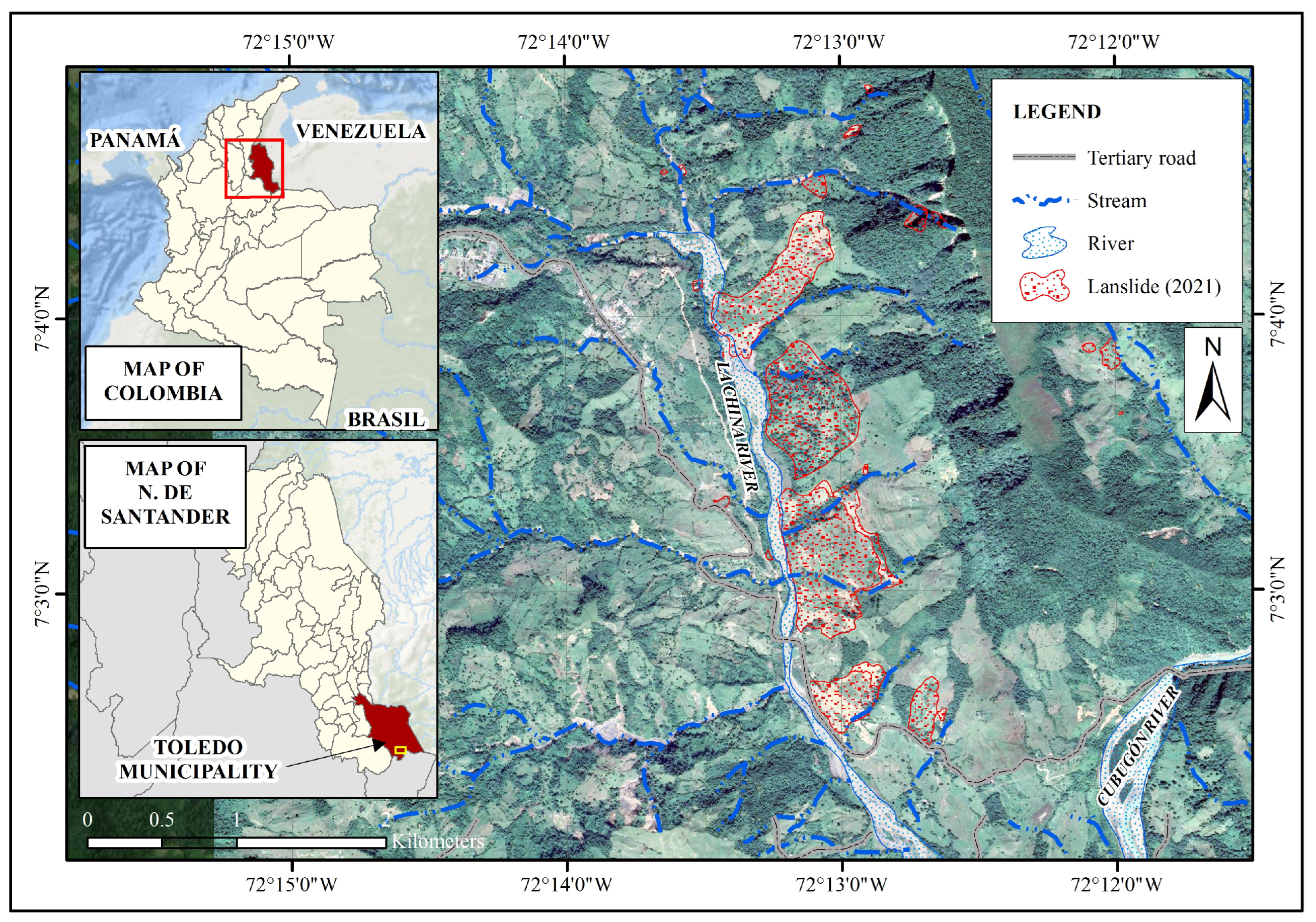
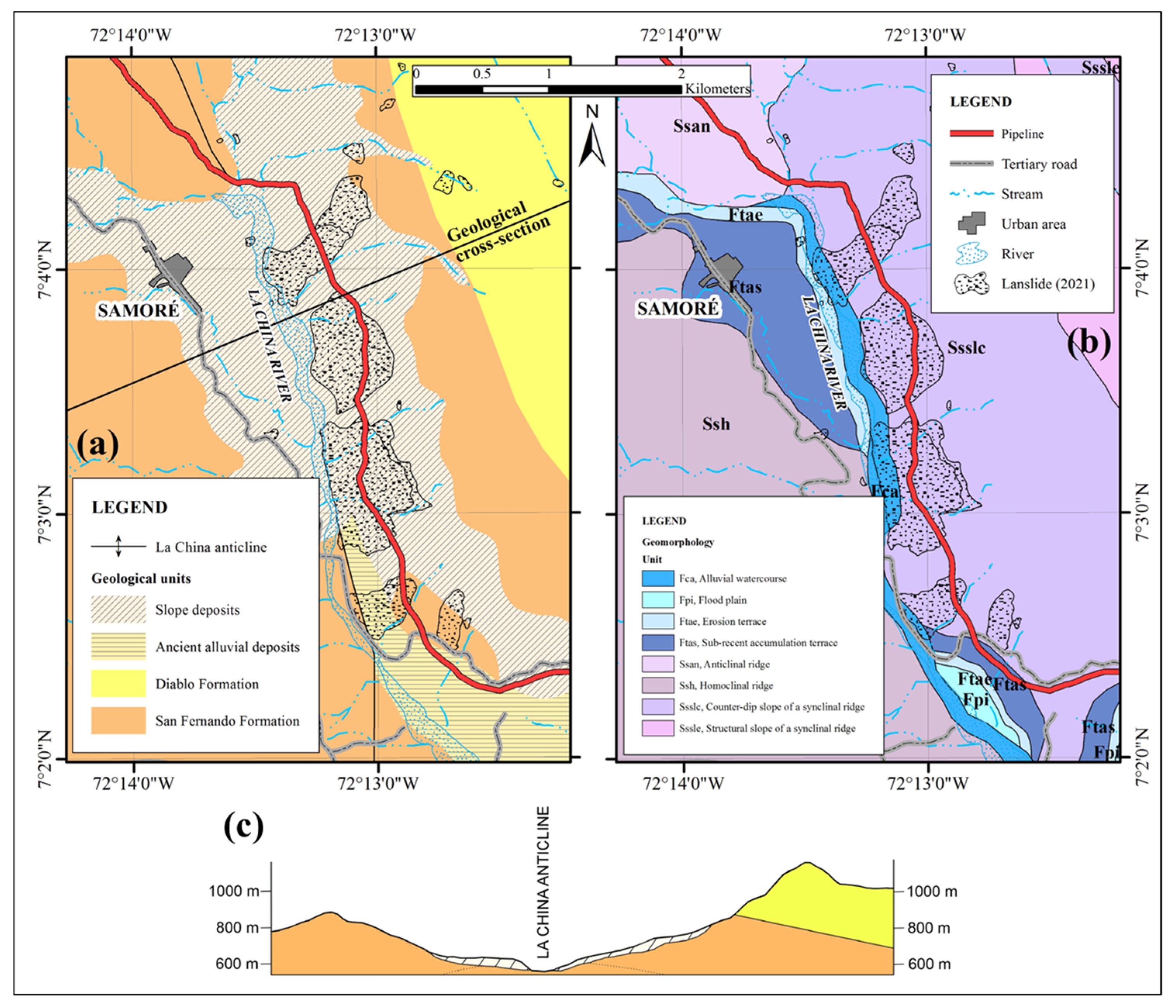
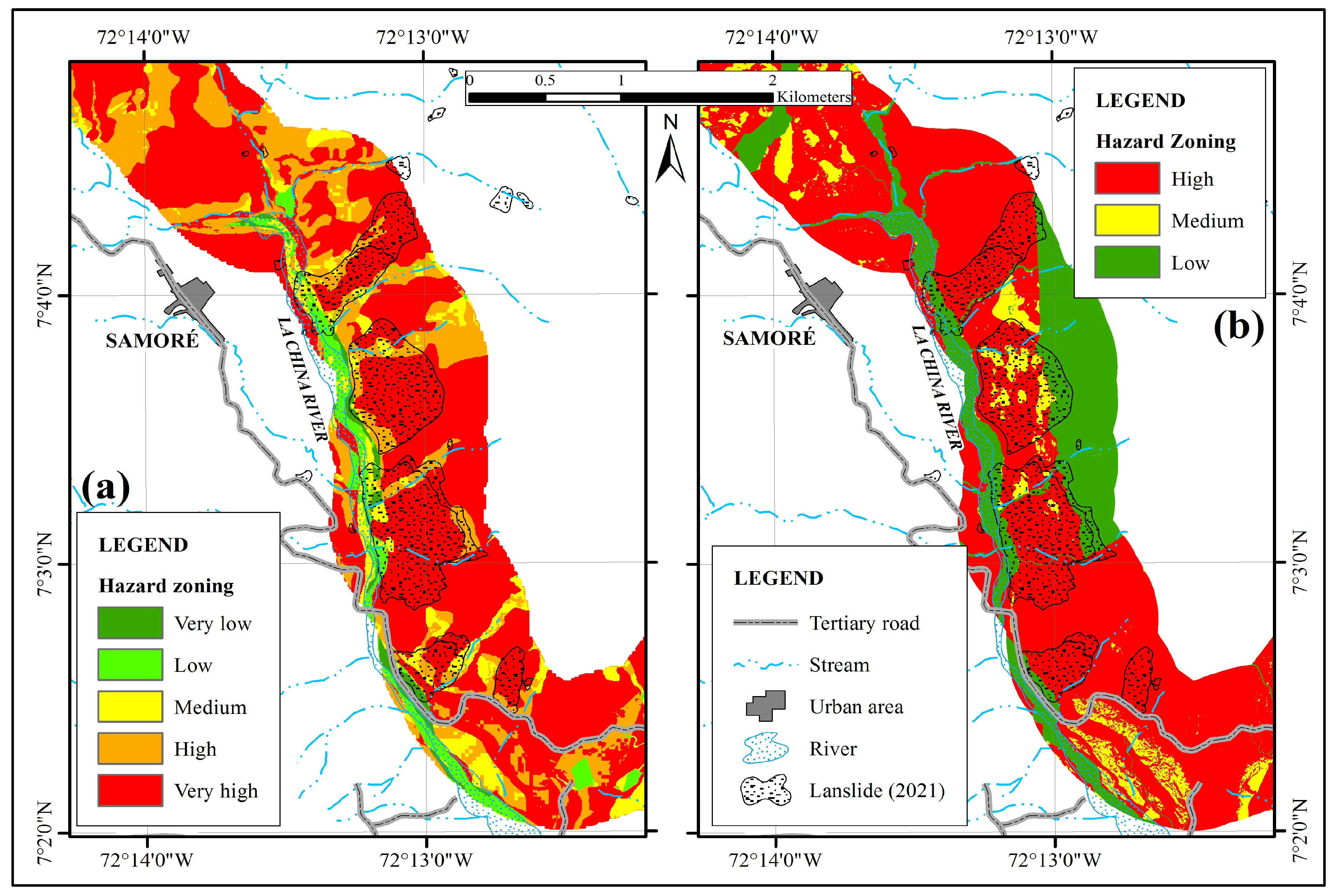
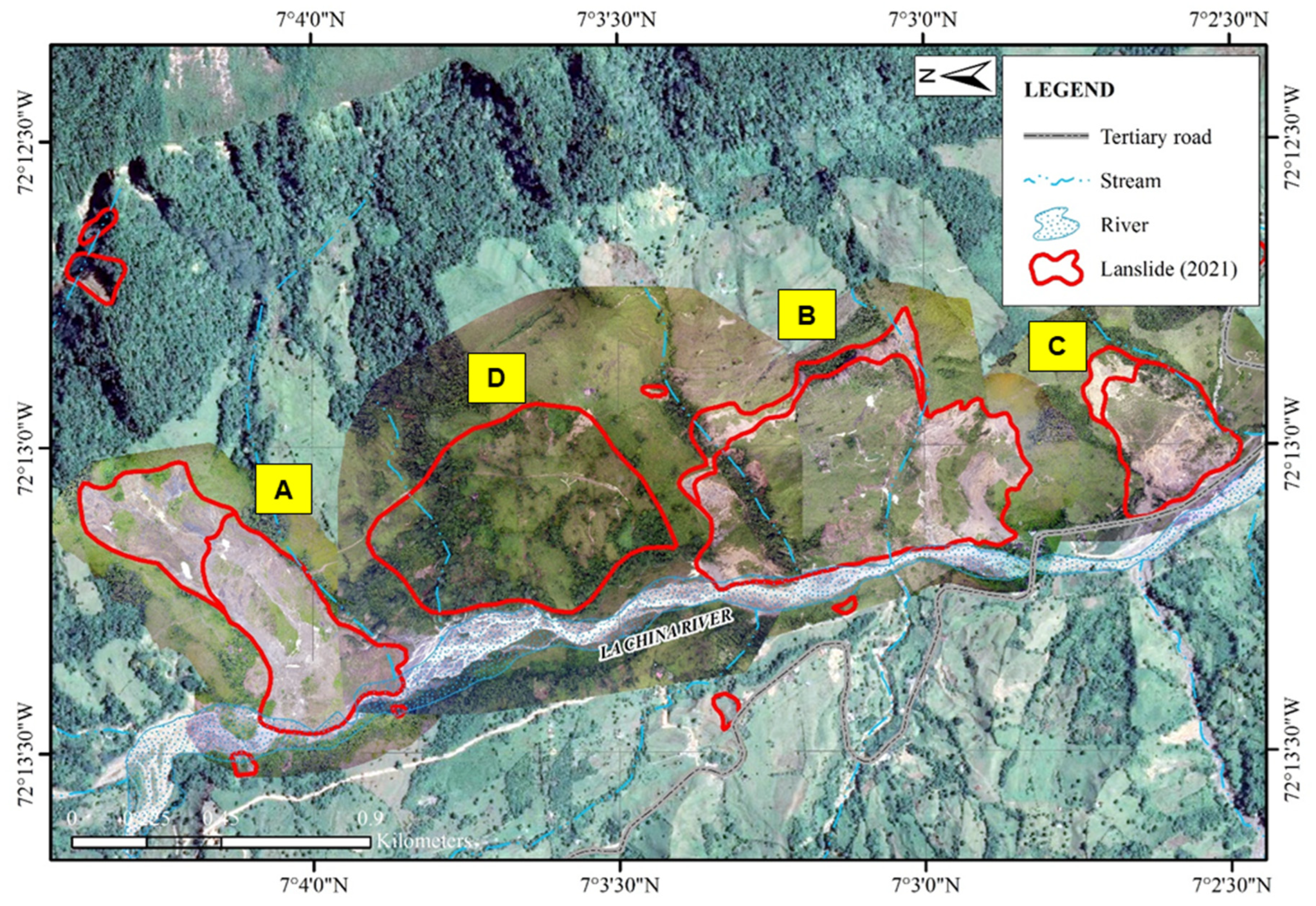
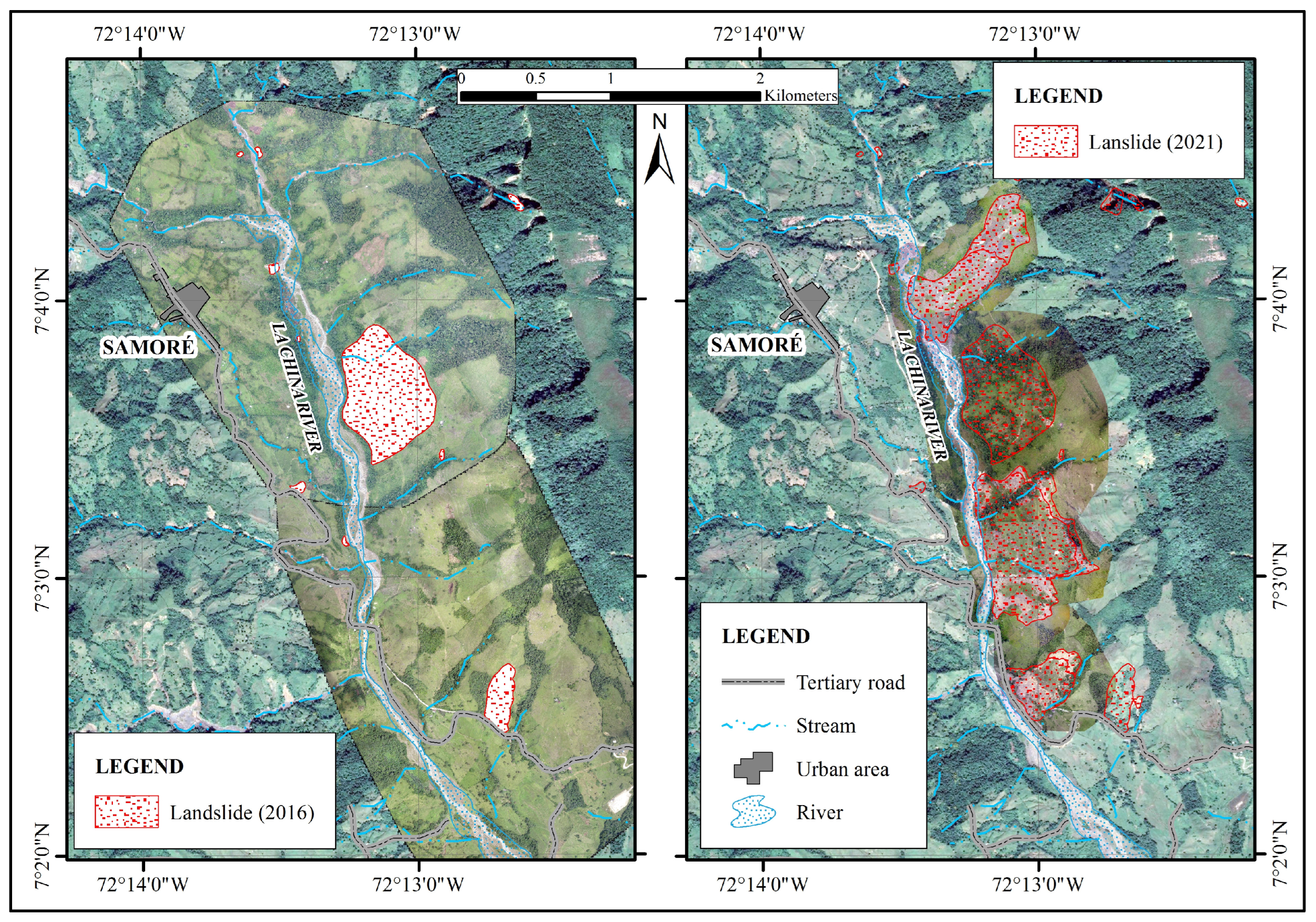
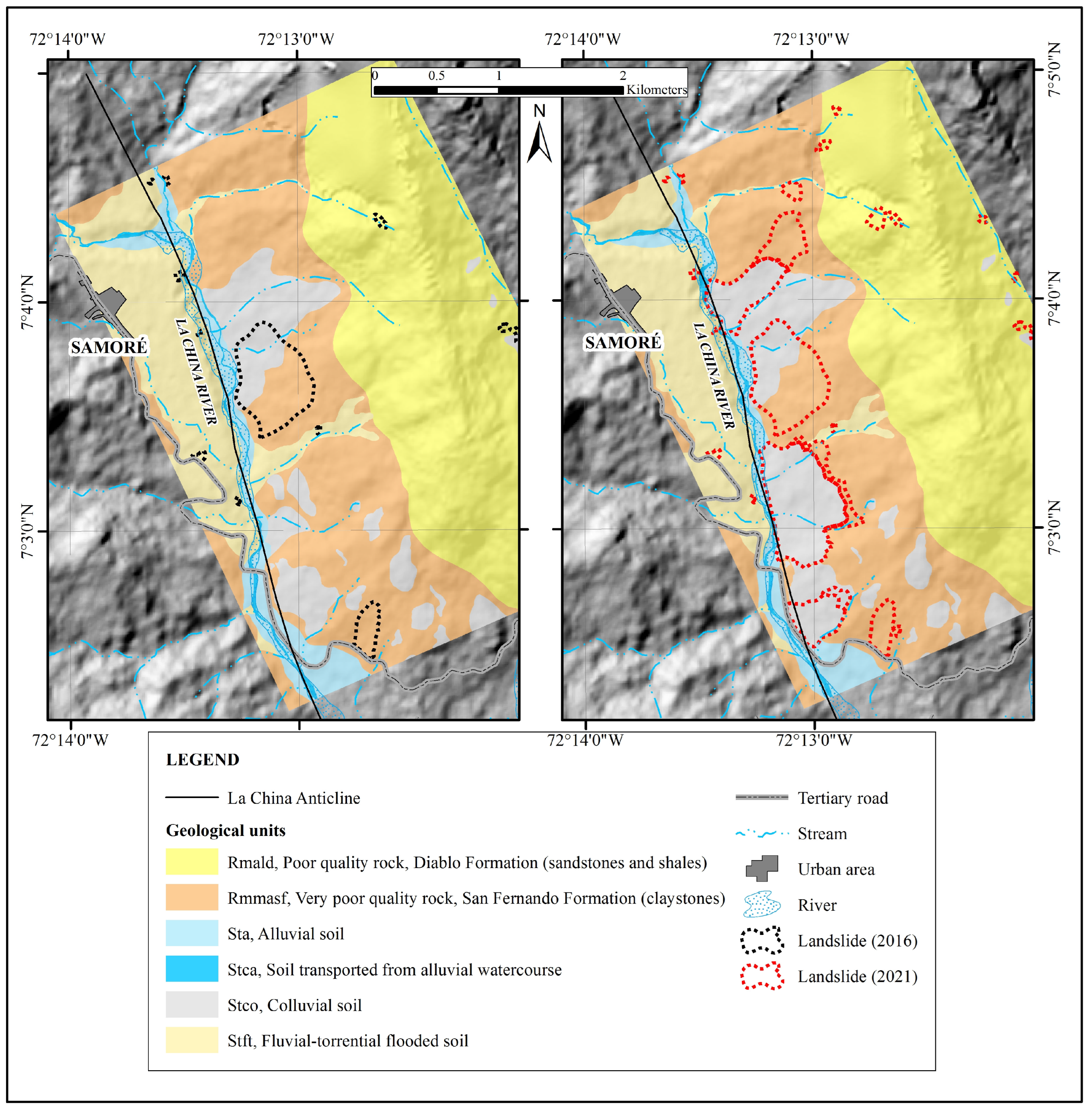
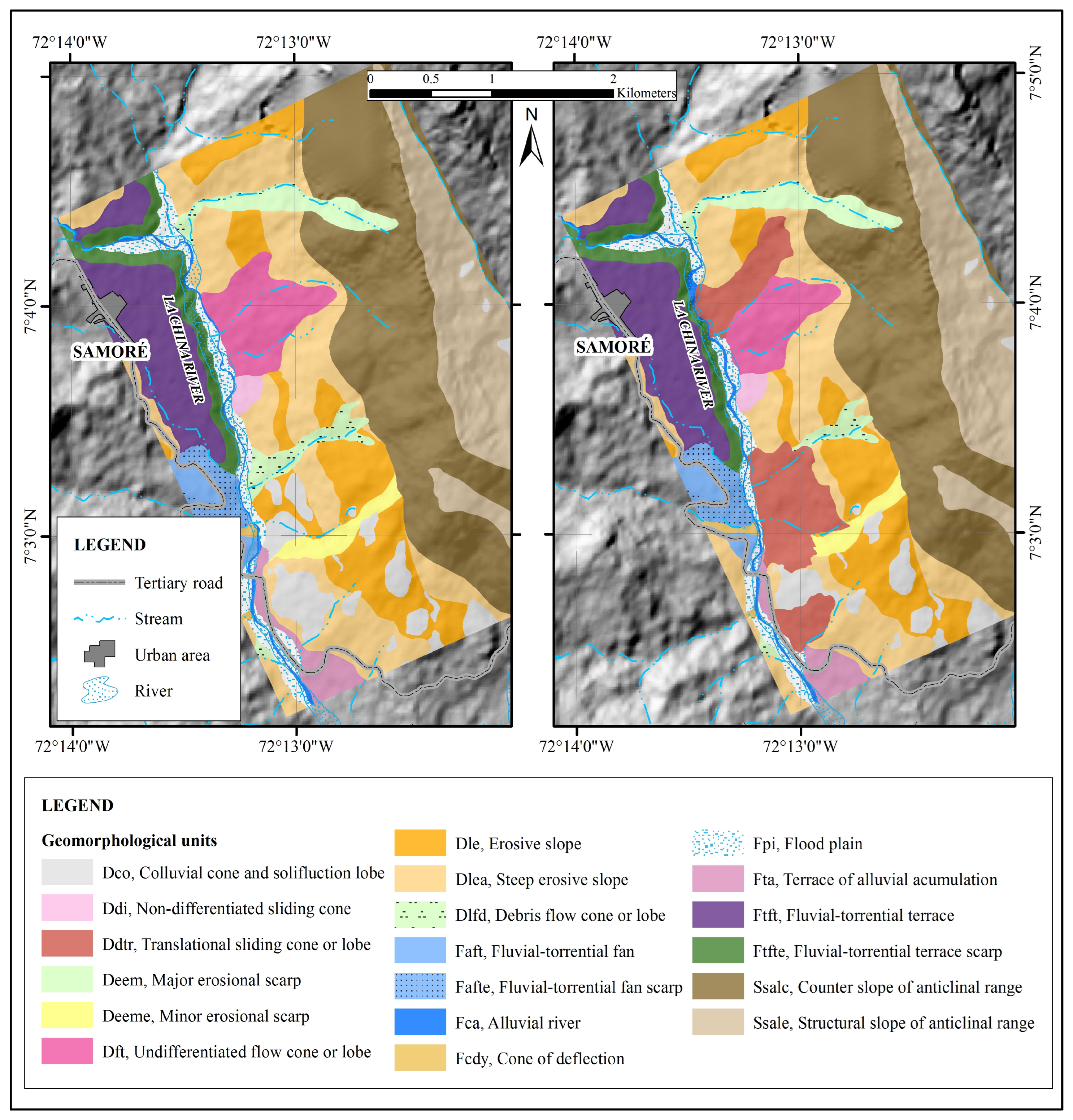

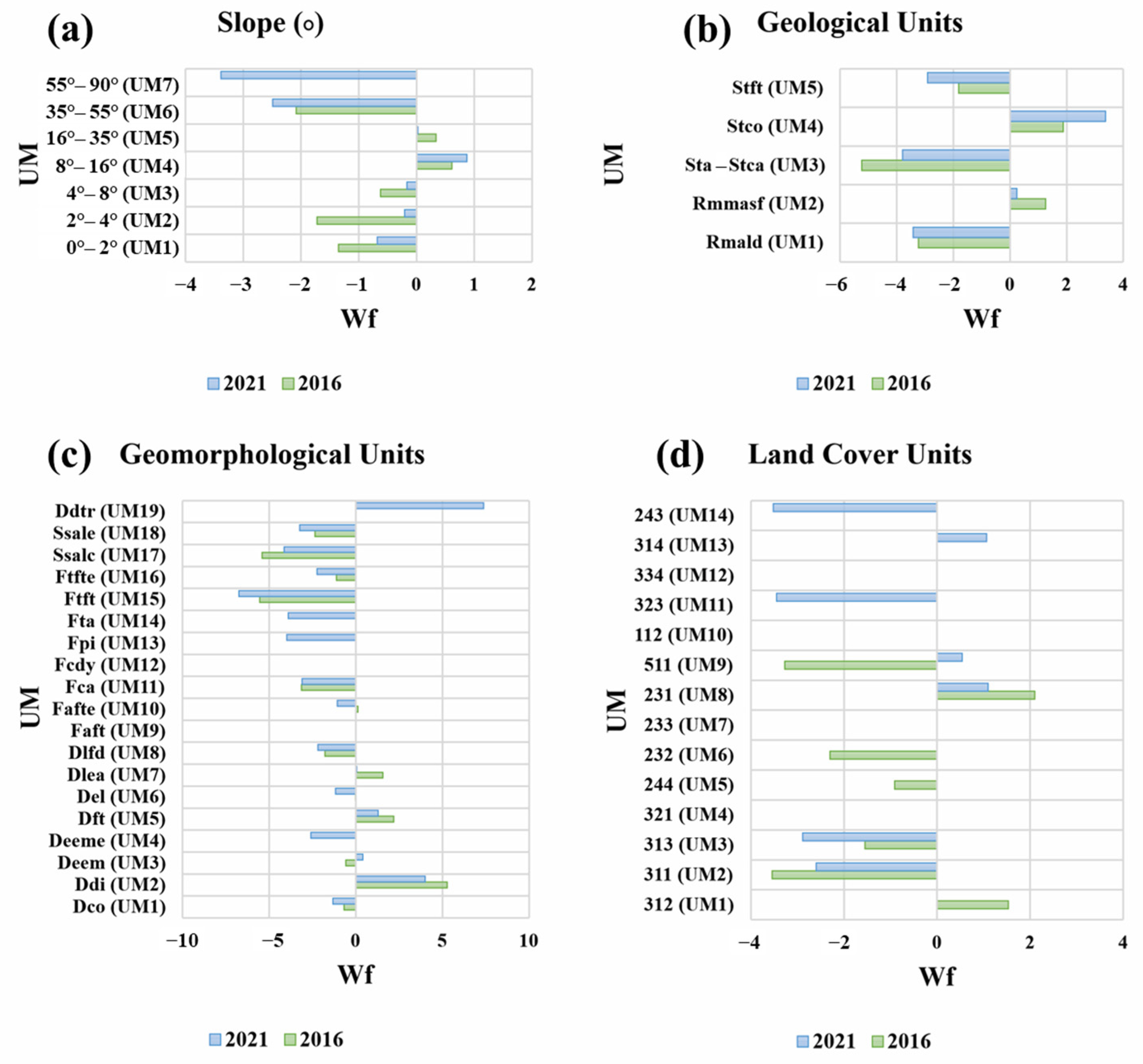
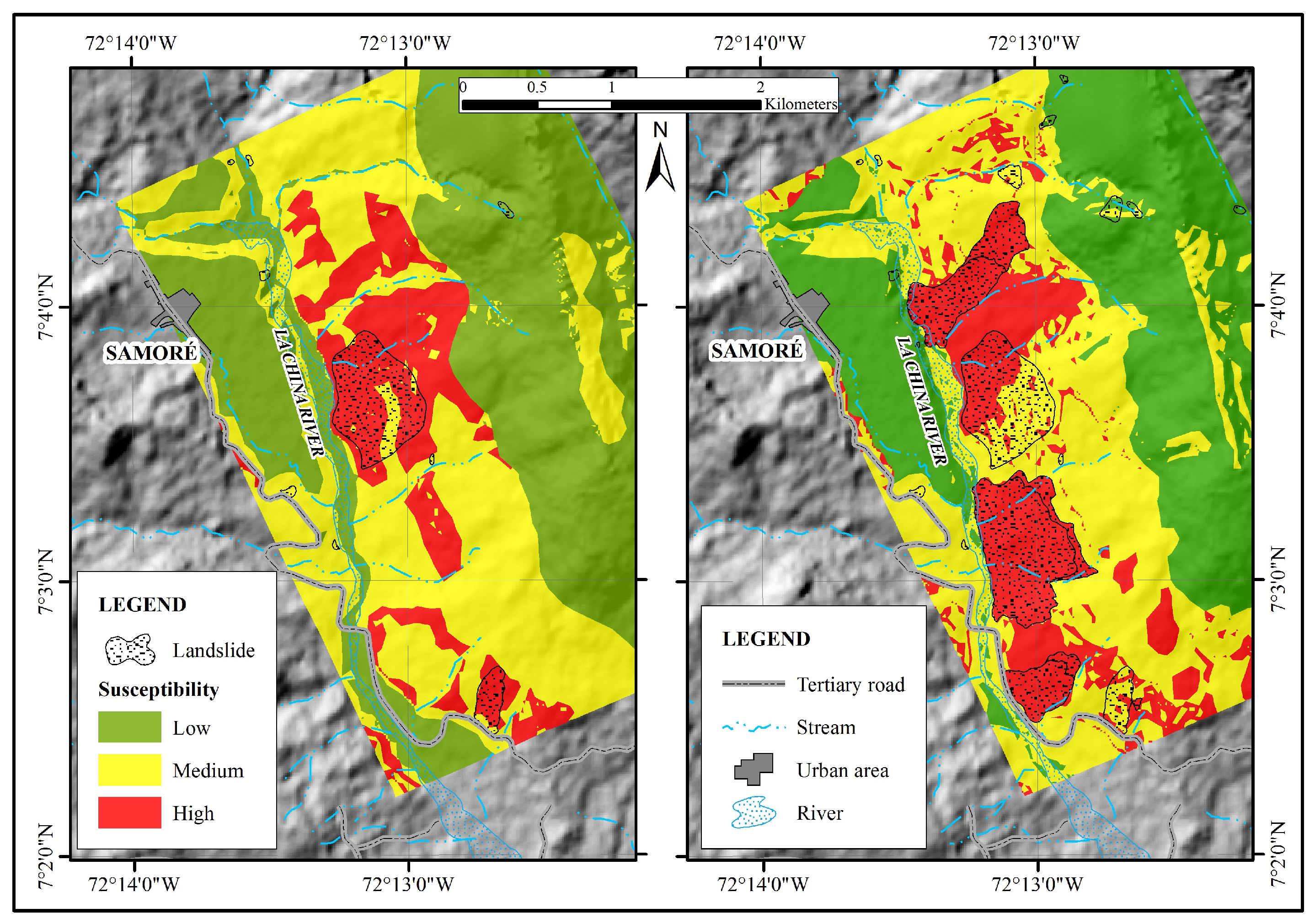


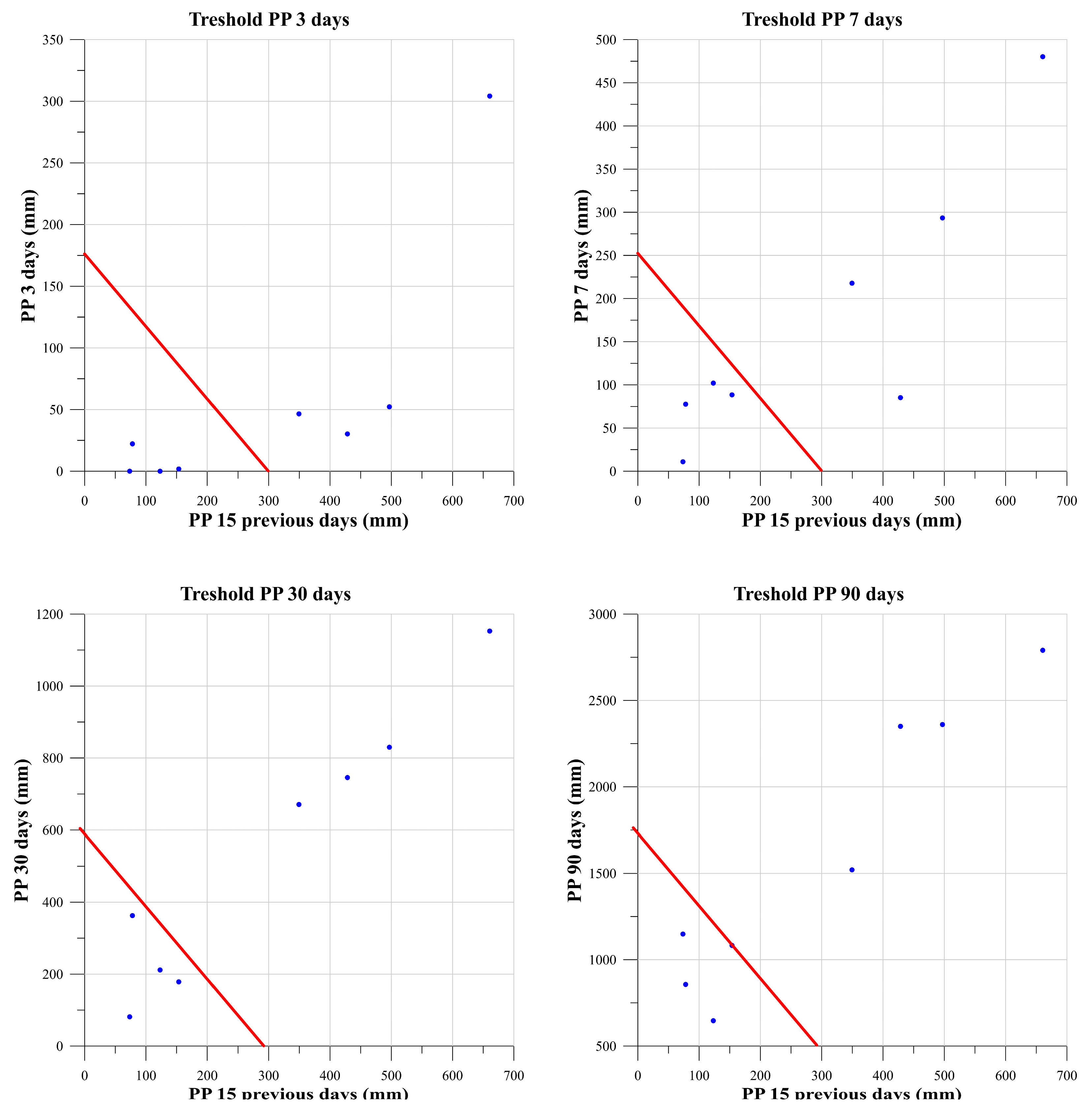
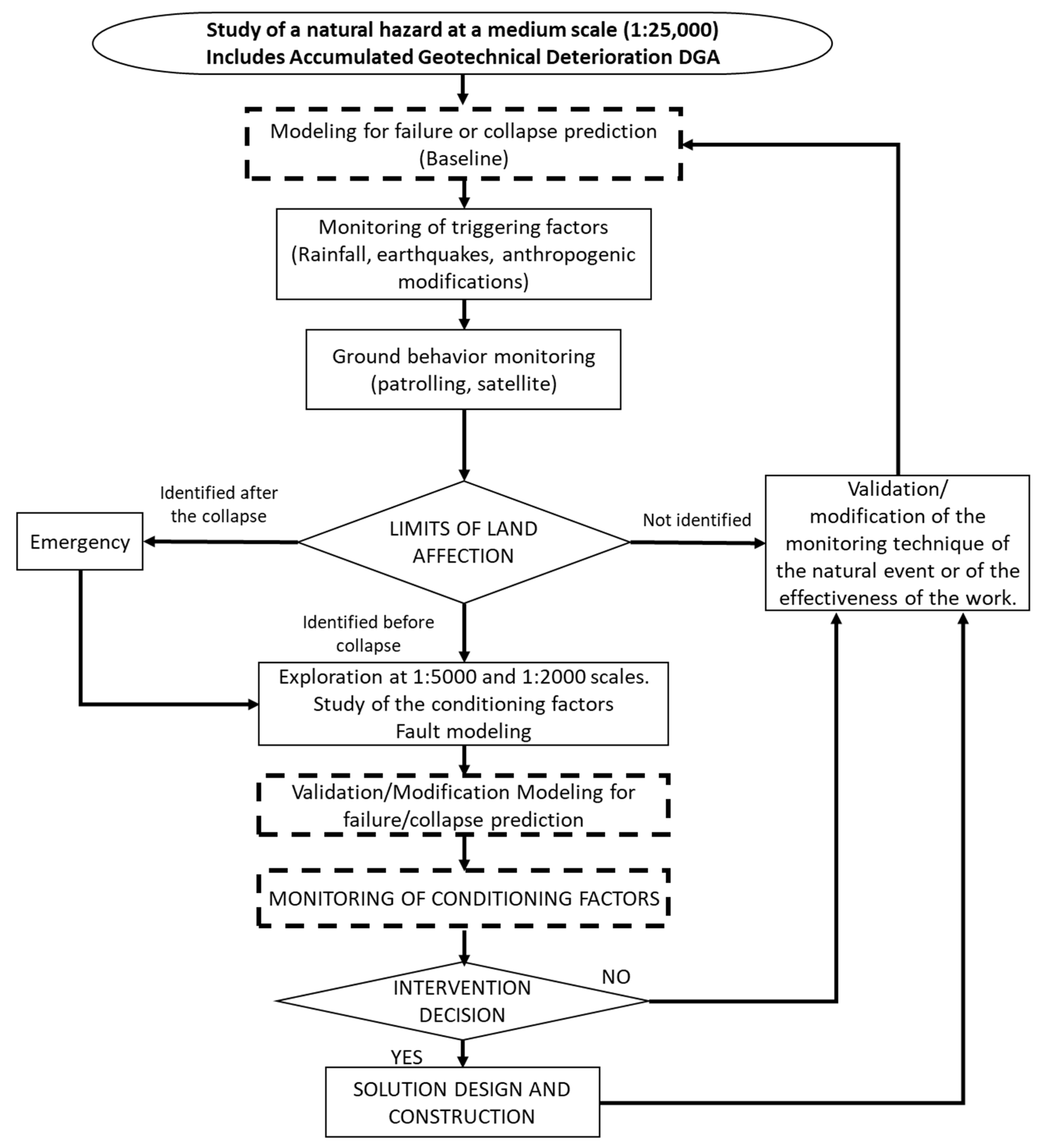

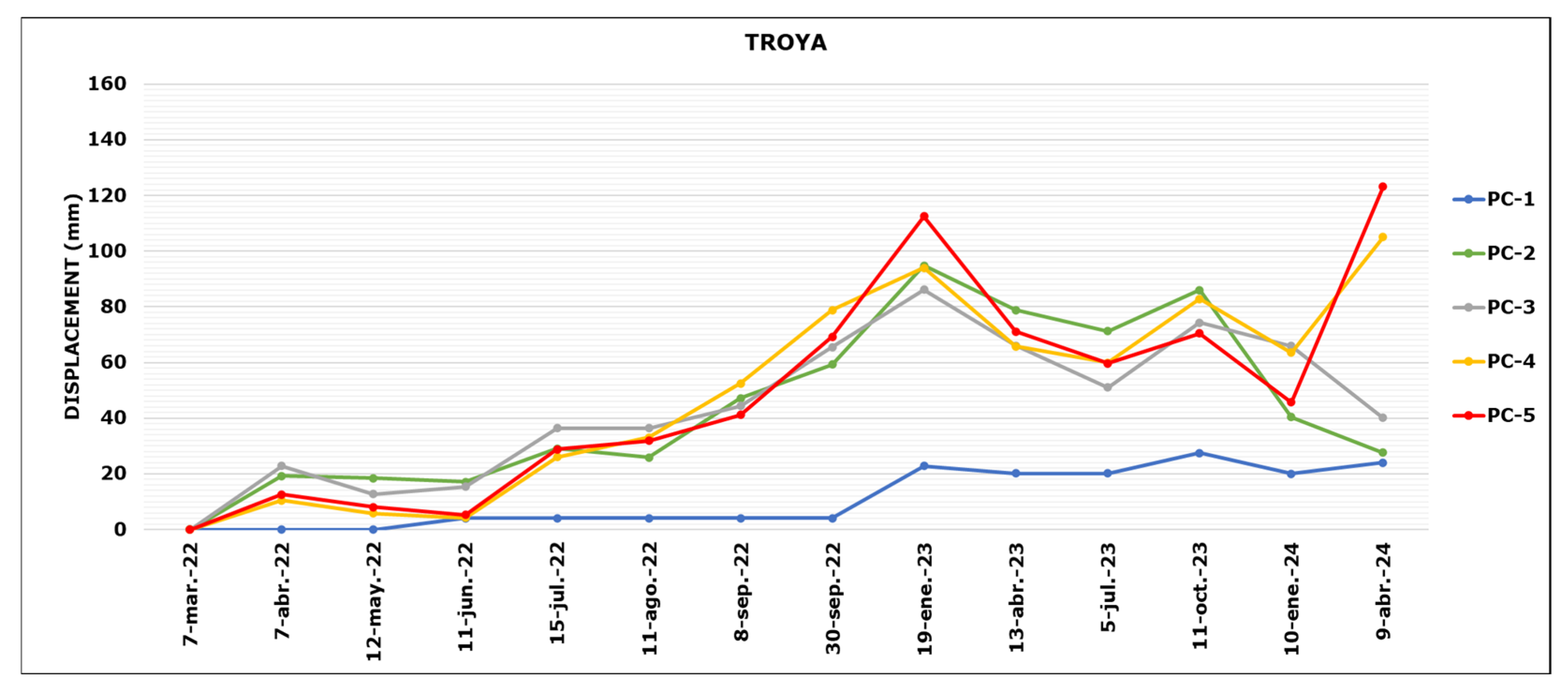
| Slope | Characteristic Processes and Terrain Conditions |
|---|---|
| 0–2 | Flat to nearly flat. No appreciable denudation. |
| 2–4 | Gently sloping. Low-speed mass movements and various types of erosion processes, especially under periglacial (solifluction) and fluvial (sheet erosion and rill erosion) conditions. Susceptible to developing erosional processes. |
| 4–8 | Sloping. Similar conditions to the previous ones. High susceptibility to developing erosional processes. |
| 8–16 | Moderately steep. Mass movements of all types, especially periglacial solifluction, creep, and occasionally slides, as well as laminar and gully erosion. Susceptible to erosion and landslides. |
| 16–35 | Steep. Intense denudational processes of different types (erosion under forest cover, creep, landslides). High propensity for the development of erosive process |
| 35–55 | Very steep. Rocky outcrops, intense denudational processes, chaotic granular deposits of low thickness. |
| >55 | Extremely steep. Rocky outcrops. Very strong denudational processes, especially “scarp denudation”; susceptible to rock rolling. |
| Conditioning Factor with Landslide Potential | ||||
|---|---|---|---|---|
| Present | Absent | |||
| Landslides | Present | Npix1 | Npix2 | Total slid area |
| Absent | Npix3 | Npix4 | Total no slid area | |
| Criteria | ||
|---|---|---|
| Indicates the Importance of the Presence of the Factor in the Landslide | Indicates the Importance of the Absence of the Factor in the Landslide | |
| >0 | Positive, indicates that the presence of the factor contributes to the occurrence of the landslide; its magnitude indicates the degree of direct correlation or the degree of contribution. | Positive, indicates that the absence of the factor contributes to the occurrence of the landslide. |
| =0 | Indicates that the factor is not relevant. | Indicates that the factor is not relevant. |
| <0 | Negative, indicates that the presence of the factor contributes to the absence of the landslide, with its magnitude indicating the degree of inverse correlation. | Negative, indicates that the absence of the factor contributes to the absence of the landslide. |
| Data | Cumulative Rainfall Prior to the Landslide | Location | |
|---|---|---|---|
| P 24 h | P15 Days | ||
| 3 August 2021 | 113.0 | 660.6 | Study area |
| 15 January 2020 | 0.3 | 78.0 | Study area |
| 22 December 2018 | 0.0 | 73.5 | To 4 km Approx., |
| 16 February 2018 | 16.7 | 123.1 | To 6 km Approx. |
| 9 January 2018 | 27.3 | 153.6 | To 5 km Approx. |
| 20 August 2017 | 37.2 | 428.5 | Study area |
| 11 August 2017 | 47.8 | 497.0 | Study area |
| 13 June 2016 | 12.5 | 349.4 | To 3 km Approx. |
| Susceptibility | 2016 | 2021 | ||
|---|---|---|---|---|
| Area (Ha) | % | Area (Ha) | % | |
| Low | 713.57 | 52.3 | 604.68 | 44.3 |
| Medium | 482.65 | 35.4 | 525.24 | 38.5 |
| High | 167.73 | 12.3 | 234.03 | 17.2 |
| Accumulated Precipitation (mm) | |||
|---|---|---|---|
| Slope | 26 August 2015 | 3 August 2021 | 30 May 2024 |
| 0–2 | 74.0 | 304.2 | 292.1 |
| 2–4 | 168.0 | 480.2 | 437.1 |
| 4–8 | 300.8 | 660.6 | 690.6 |
| 8–16 | 643.7 | 1152.8 | 1151.3 |
| 16–35 | 1154.5 | 2087.8 | 2113.5 |
| 35–55 | 1744.7 | 2790.5 | 2803.9 |
Disclaimer/Publisher’s Note: The statements, opinions and data contained in all publications are solely those of the individual author(s) and contributor(s) and not of MDPI and/or the editor(s). MDPI and/or the editor(s) disclaim responsibility for any injury to people or property resulting from any ideas, methods, instructions or products referred to in the content. |
© 2024 by the authors. Licensee MDPI, Basel, Switzerland. This article is an open access article distributed under the terms and conditions of the Creative Commons Attribution (CC BY) license (https://creativecommons.org/licenses/by/4.0/).
Share and Cite
Buenahora Ballesteros, C.A.; Martínez-Graña, A.M.; Yenes, M. Influence of Cumulative Geotechnical Deterioration on Mass Movement at a Medium-Scale Regional Analysis (Cortinas Sector, Toledo, Colombia). Land 2024, 13, 1000. https://doi.org/10.3390/land13071000
Buenahora Ballesteros CA, Martínez-Graña AM, Yenes M. Influence of Cumulative Geotechnical Deterioration on Mass Movement at a Medium-Scale Regional Analysis (Cortinas Sector, Toledo, Colombia). Land. 2024; 13(7):1000. https://doi.org/10.3390/land13071000
Chicago/Turabian StyleBuenahora Ballesteros, Carlos Andrés, Antonio Miguel Martínez-Graña, and Mariano Yenes. 2024. "Influence of Cumulative Geotechnical Deterioration on Mass Movement at a Medium-Scale Regional Analysis (Cortinas Sector, Toledo, Colombia)" Land 13, no. 7: 1000. https://doi.org/10.3390/land13071000
APA StyleBuenahora Ballesteros, C. A., Martínez-Graña, A. M., & Yenes, M. (2024). Influence of Cumulative Geotechnical Deterioration on Mass Movement at a Medium-Scale Regional Analysis (Cortinas Sector, Toledo, Colombia). Land, 13(7), 1000. https://doi.org/10.3390/land13071000









